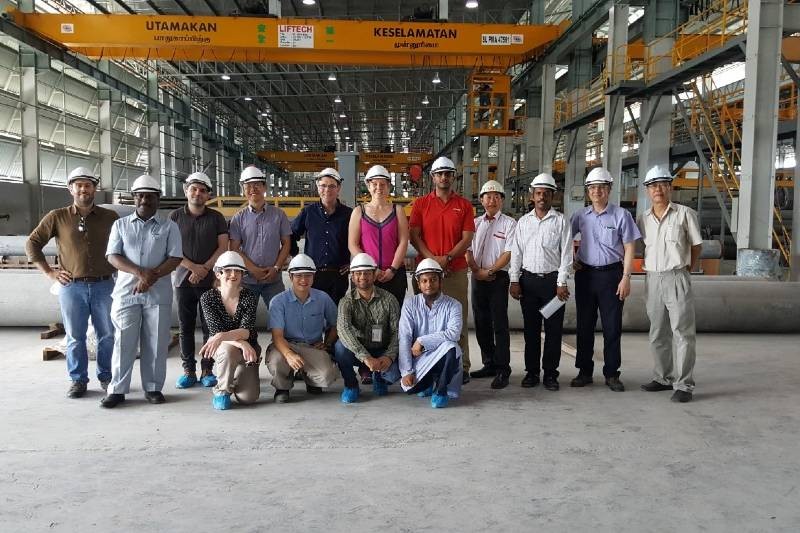Low carbon footprint precast concrete products for an energy efficient built environment (LowCoPreCon)
The environmental benefits of reusing waste stream materials include the reduced risks to soil, water and ecology by avoidance of disposal to land of hazardous wastes. The elimination of cement from precast concrete products (at an embodied rate of 930 kg of CO2 per tonne of cement) will provide considerable carbon savings to both the UK and Malaysian construction industries. The project aims to manifest the sustainability “Proximity Principle” of having the waste stream consumed within the same close geographic area. A Life Cycle Analysis of the new process will be carried out to deliver an unbiased environmental assessment of the proposed cementless dwelling. The social benefits include developing improved building typologies for people living in urban and rural deprived areas. The demonstration dwelling will offer an alternative system of housing provision that mainstreams support networks and community building. Sustainable consumption is achieved through the use of local, recycled materials and socially inclusive and empowering construction techniques. This mechanism will reshape socio-technical infrastructures of housing provision which will align affordability, access and sustainability priorities consistent with UK Official Development Assistance. Social benefits will also include the creation/protection of specialist jobs that will increase new skills and innovation.
This project is funded by:
(i) “REcovery and uSe of Cement kIlN Dust as the alkali activator for Geopolymeric (Cementless) Concrete Building Blocks (RESCIND)”, EPSRC/Innovate ref nr: EP/N508962/1, Total grant value: £193K, Status: completed,
https://ukerc.rl.ac.uk/cgi-bin/ercri5.pl?GChoose=gecatsum&GRN=EP/N508962/1&GSumCat=99&GCatSum=2787&HTC=2E447519&SHTC=5A90D6
(ii) “Converting waste glass into waterglass”, Invest Northern Ireland funded PoC project, Total grant value: £111K, Status: ongoing.
(iii) “Glass cUllet conversIon To wAteRglass (GUITAR)”, funded by Innovate UK, under competition call “ISCF Transforming foundation industries: Building a resilient recovery”, Total grant value: £641K (£253K funding in cash for QUB and remaining £388K between 4 industrial partners), Status: starting on 1/4/2021.
McGrath, T.; Kwasny, J.; Aiken, T.; Cox, S.; Soutsos, M.; Chen, J.F.; Mariotti, J.; Sha, W.; Correia Lopes, R. F., “Demonstration of using low carbon precast concrete products for an energy efficient built environment” Fifth International Conference on Sustainable Construction Materials and Technologies (SCMT5) - Kingston University, London, United Kingdom, 14 to 17 Jul 2019.
Kwasny, J., McGrath, T., Lawther, S., Soutsos, M., Sha, W., Cox, S., Chen, J. F. & Correia Lopes, R. F., “Lagoon fly ash: A potential source of the precursor for geopolymer binders,” EUROCOALASH2019 Proceedings. McCarthy, M. J., Newlands, M. D., Jones, M. R., Dyer, T. D., Csetenyi, L. J. & Zheng, L. (eds.). University of Dundee, 10 Jun 2019, pp. 322-333.
McGrath, T., Kwasny, J., Aiken, T., Cox, S., Soutsos, M., Mariotti, J., Correia Lopes, R. F. & Toal, S., “LowCoPreCon – Low Carbon Precast Concrete Products for an Energy Efficient Built Environment,” RILEM Proceedings PRO128: Proceedings of the International Conference on Sustainable Materials, Systems and Structures (SMSS2019) New Generation of Construction Materials. Serdar, M., Stirmer, N. & Provis, J. (eds.). Paris, France, 22 Mar 2019, pp. 541-549.
The School of Natural and Built Environment at Queen's University Belfast is one of several partners involved in this project. Details of all partners are as follows:
Macrete Ireland Limited http://www.macrete.com/contact-us/
Creagh Concrete Products Limited, UK www.creaghconcrete.co.uk
Sunway Paving Solutions, Malaysia www.sunwaypavingsolutions.com/
Ikhmas Jaya Group Berhad, Malaysia www.ikhmasjaya.com/
Monash University, Malaysia www.monash.edu/
Centre for Innovative Construction Technology (CICT), Department of Civil Engineering, University of Malaya, Malaysia https://cict.um.edu.my/
This project aims to address the following SDGs:
Goal 9 - Industry, Innovation and Infrastructure
This will be achieved by providing opportunity to generate an added-value chemical, i.e. waterglass, in a cost- and energy efficient manner.
Goal 11 - Sustainable Cities and Communities
Project fits well within the urban mining strategies for waste management (waste glass) and the 3R policy of circular economy.
Goal 12 - Responsible Consumption and Production
This will be accomplished by conservation of virgin material and instead usage of waste glass in creation of added-value product (waterglass).
Goal 13 - Climate Action
This goal will be reached by lowering the carbon footprint of the high energy demanding waterglass making process, and ultimately in generating ultra-low carbon concrete.
- Marios Soutsos
Professor of Structures/Materials
School of Natural and Built Environment
Queen's University
David Keir Building
Stranmillis Road
Belfast BT9 5AG - m.soutsos@qub.ac.uk
Tel: +44 (0)28 9097 4023
Fax: +44 (0)28 9097 4278

